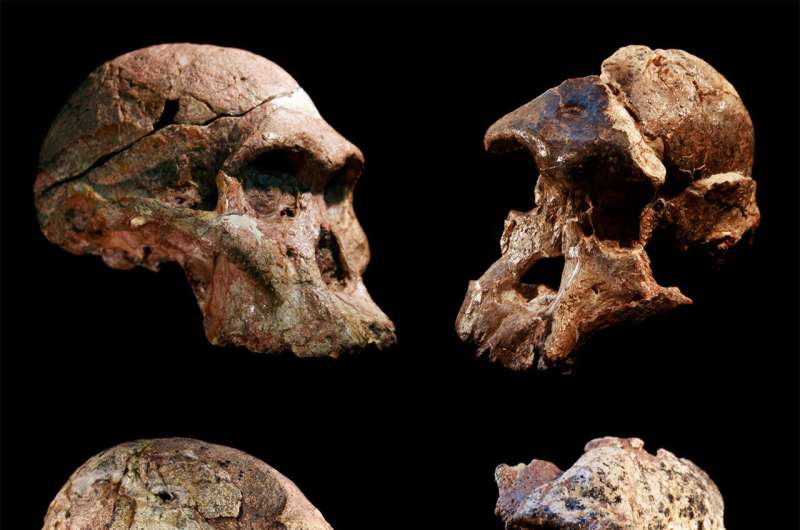Welcome to DU!
The truly grassroots left-of-center political community where regular people, not algorithms, drive the discussions and set the standards.
Join the community:
Create a free account
Support DU (and get rid of ads!):
Become a Star Member
Latest Breaking News
General Discussion
The DU Lounge
All Forums
Issue Forums
Culture Forums
Alliance Forums
Region Forums
Support Forums
Help & Search
Anthropology
Related: About this forumFossils in the 'Cradle of Humankind' may be more than a million years older than previously thought

Four different Australopithecus crania that were found in the Sterkfontein caves, South Africa.
The earth doesn't give up its secrets easily—not even in the "Cradle of Humankind" in South Africa, where a wealth of fossils relating to human evolution have been found.
For decades, scientists have studied these fossils of early human ancestors and their long-lost relatives. Now, a dating method developed by a Purdue University geologist just pushed the age of some of these fossils found at the site of Sterkfontein Caves back more than a million years. This would make them older than Dinkinesh, also called Lucy, the world's most famous Australopithecus fossil. The "Cradle of Humankind" is a UNESCO World Heritage Site in South Africa that comprises a variety of fossil-bearing cave deposits, including at Sterkfontein Caves. Sterkfontein was made famous by the discovery of the first adult Australopithecus, an ancient hominin, in 1936. Hominins includes humans and our ancestral relatives, but not the other great apes. Since then, hundreds of Australopithecus fossils have been found there, including the well-known Mrs. Ples, and the nearly complete skeleton known as Little Foot. Paleoanthropologists and other scientists have studied Sterkfontein and other cave sites in the Cradle of Humankind for decades to shed light on human and environmental evolution over the past 4 million years.
Darryl Granger, a professor of earth, atmospheric, and planetary sciences in Purdue University's College of Science, is one of those scientists, working as part of an international team. Granger specializes in dating geologic deposits, including those in caves. As a doctoral student, he devised a method for dating buried cave sediments that is now used by researchers all over the world. His previous work at Sterkfontein dated the Little Foot skeleton to about 3.7 million years old, but scientists are still debating the age of other fossils at the site.
In a study published in the Proceedings of the National Academy of Sciences, Granger and a team of scientists including researchers from the University of the Witwatersrand in Johannesburg, South Africa and the University Toulouse Jean Jaurès in France, have discovered that not only Little Foot, but all of the Australopithecus-bearing cave sediments date from about 3.4 to 3.7 million years old, rather than 2-2.5 million years old as scientists previously theorized. That age places these fossils toward the beginning of the Australopithecus era, rather than near the end. Dinkinesh, who hails from Ethiopia, is 3.2 million years old, and her species, Australopithecus africanus, hails back to about 3.9 million years old.
/SNIP
https://phys.org/news/2022-06-fossils-cradle-humankind-million-years.html?fbclid=IwAR1q8vfPhvJnex369ELGrGyPlDeOAe8rd2QbmMI-CVt5kduCjp1N5_EOPic
InfoView thread info, including edit history
TrashPut this thread in your Trash Can (My DU » Trash Can)
BookmarkAdd this thread to your Bookmarks (My DU » Bookmarks)
2 replies, 1365 views
ShareGet links to this post and/or share on social media
AlertAlert this post for a rule violation
PowersThere are no powers you can use on this post
EditCannot edit other people's posts
ReplyReply to this post
EditCannot edit other people's posts
Rec (25)
ReplyReply to this post
2 replies
 = new reply since forum marked as read
Highlight:
NoneDon't highlight anything
5 newestHighlight 5 most recent replies
= new reply since forum marked as read
Highlight:
NoneDon't highlight anything
5 newestHighlight 5 most recent replies
Fossils in the 'Cradle of Humankind' may be more than a million years older than previously thought (Original Post)
Tom Yossarian Joad
Jun 2022
OP
It would be truly fascinating to see what the DNA would show if we had it to link all
cstanleytech
Jun 2022
#1
cstanleytech
(26,318 posts)1. It would be truly fascinating to see what the DNA would show if we had it to link all
such fossils.
70sEraVet
(3,508 posts)2. Good article. Thanks, TYJ!
May they can tell us where human evolution went wrong!
So its taken nearly 4 million years to get here. Hope the trip was worth it.